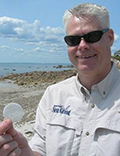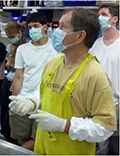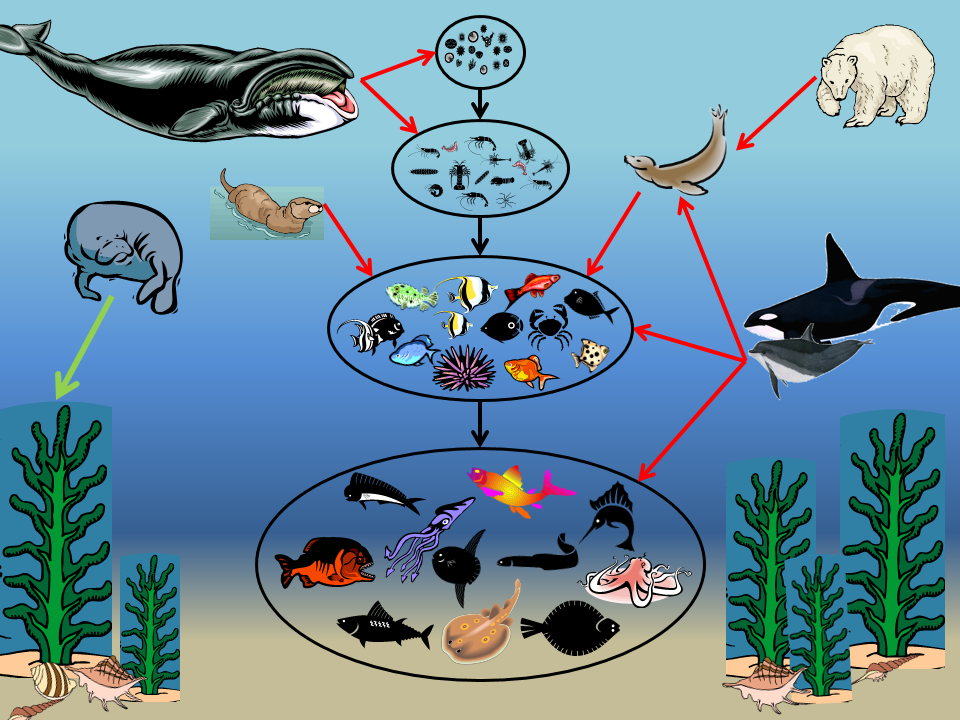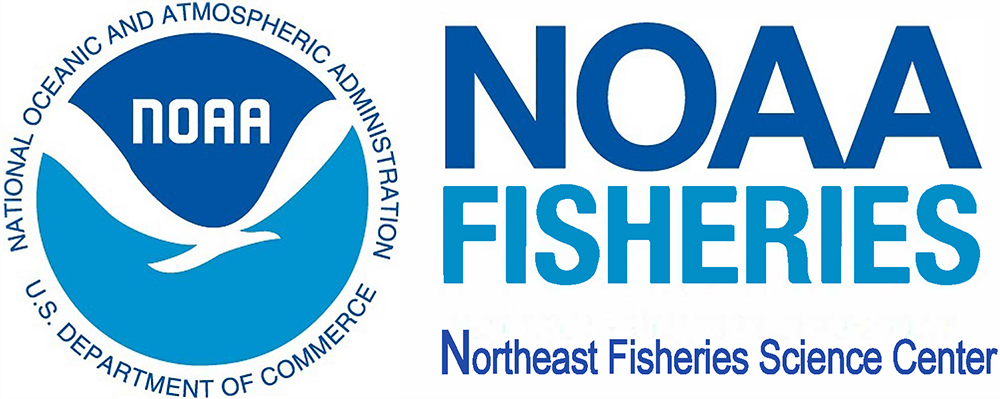Food Webs
Background
Food webs are dynamic and complex. Species in each trophic or feeding level rely on their prey base and in turn are critically important to the organisms that feed on them. Energy travels through the food web and steadily decreases with each trophic level it passes through as some is used for movement, some is used in digestion, some food is not digested, etc. In general, as you move through the food web, each successive higher level of consumer is made up of fewer, larger organisms. Most marine mammals are top level consumers, meaning that they are at the end (or close to the end) of their food chain in the web. This means that anything that affects their prey or food will affect the numbers and health of those specific marine mammals. Marine mammals can also be affected by competition with other species for the same resources Overfishing, changes in prey numbers and distribution in response to climate change, and other factors affect the food web.
In this lesson, students will learn about the marine food web and trophic levels and be able to place marine mammals in their proper place on the food web. They will explore the relationship between all the organisms on the web and hypothesize how impacts on one species in the web can impact the whole food web. They will discuss how humans affect the food web and what they can do to make a difference.
Lesson Plans
K-5
Activity Sheets/Handouts
This lesson meets the following Next Generation Science Standards:
- Grades K-2:
- K-LS1-1 - Use observations to describe patterns of what plants and animals (including humans) need to survive. In this lesson students are asked to compare plant and animal needs and where their energy requirements place them in the food web.
- K-ESS3-1 - Use a model to represent the relationship between the needs of different plants and animals (including humans) and the places they live. In this lesson students build both a terrestrial and ocean food web and explore the different feeding strategies employed by marine mammals as their habitat affects the location of "plants".
- 2-LS4-1 - Make observations of plants and animals to compare the diversity of life in different habitats. Students compare and contrast what they know of terrestrial plants and animals with plankton and marine mammal samples and relate that to habitat information.
- Grades 3-5:
- 5-LS2-1 - Develop a model to describe the movement of matter among plants, animals, decomposers, and the environment. In this lesson students make a model, marine food web.
- 5-PS3-1 - Use models to describe that energy in animals' food (used for body repair, growth, motion, and to maintain body warmth) was once energy from the sun. Students construct a food web and investigate how the suns energy travel's through that web.
Additional Resources
- Smithsonian National Museum of National History: Ocean Portal for educators with great videos and information.
- Bridge: Teacher approved marine education materials.
- Sheppard Software's Kid's Corner: Food chain games and information.
- Science Kids: Food chains game- this simple interactive game allows you to spot living things, sort them into categories, and put them in a food chain.
- Arctic Ocean Diversity:Some amazing images that you can use to construct food webs or just discuss the rarely seen members of the marine food web.
- ARKive: Many lesson packs for teachers geared towards specific age groups.
- WhaleTimes SeaBed:Whales, dolphins, sharks, penguins, and more!
- Fish and People: 5 video and lesson modules using animation to visualize the human-fish relationship.
- Ocean Drifters: a secret world beneath the waves:Video about the life and roll of plankton in the marine food web.
- NOAA Northwest Fisheries Science Center:Check out highly magnified images of some of the tiniest creatures in the sea!
- "Help Save Menhaden":This video from Pew illustrates the importance of menhaden in the food web.
This program is a collaboration between the NOAA Northeast Fisheries Science Center and Woods Hole Sea Grant.
Scientist Spotlight

Communications and Outreach Specialist
Woods Hole Sea Grant
Jeffrey organizes beach clean ups and then catalogs and reports the marine debris collected. Marine debris can be mistaken for food and disrupt the food web.

Research Fishery Biologist
Northeast Fisheries Science Center
Fred is involved in marine mammal feeding ecology research which includes the movement and foraging activities of marine mammals.




